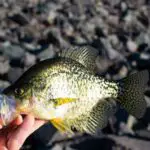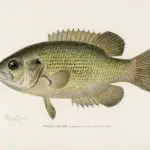After spawning, crappies generally head back to deeper water and frequently scatter. This can make them more difficult to find. However, there are a few places you can look for them. First, try near deep woody cover, such as sunken trees or brush piles. You might also look for any rises, drops, ledges, stumps, rock piles or anything different on the bottom contour. These areas can provide the perfect hiding spot for crappies seeking refuge from predators.
1. What is the crappie spawning process?
The spawning process for crappie is relatively simple. Male crappie build nests in shallow water, generally ranging between 1-6 feet deep. These nests are built by aggressively brushing the bottom of their caudal fins in order to clear an area for the eggs to be laid. Once the nest is built, the male will defend it against any potential threats.
The female crappie will then lay her eggs inside the nest, after which the male will fertilize them. The eggs will incubate for around 10 days before hatching into fry (young fish). The fry will stay close to the nest for a few weeks until they are large enough to fend for themselves, at which point they will disperse into open water.
It is worth noting that both male and female crappie play important roles in the spawning process; without either one, successful reproduction would not be possible.
2. Where do crappies typically spawn?
Crappies typically spawn in areas of shallow water, usually around 2-to-4 feet deep. They prefer to have cover such as brush, flooded timber or weeds, and easy access to deeper water. In areas with murky water and thick cover, crappies can sometimes be found nearly on the bank.
3. Why do crappies move after spawning?
After spawning, crappies begin to move in order to find food. They typically travel in small groups or alone and often stop to rest in between periods of travel. The main reason for their movement is to look for areas with an abundance of food so that they can continue to grow and thrive. Additionally, as water temperatures change throughout the year, crappies may move to different depths in order to find water that is comfortable for them. By moving around and exploring their environment, crappies are able to increase their chances of survival and ensure that they remain healthy and strong.
4. How far do crappies travel after spawning?
It is generally accepted that crappies do not travel far after spawning. Most research indicates that they remain in the general vicinity of their spawning site and do not venture out into open water. However, there are some reports of crappies traveling up to several miles from their spawning site in search of food or new habitat. It is believed that these fish are mostly young, inexperienced individuals that have yet to learn the importance of staying close to home.
5. What factors influence where crappies go after spawning?
When it comes to crappies, there are a few key factors that influence where they go after spawning. The first is temperature. Crappies prefer water temperatures in the range of 60-70 degrees Fahrenheit. So, if the water temperature drops below 60 degrees or rises above 70 degrees, crappies will be less likely to be found in that area.
The second factor is dissolved oxygen levels. Crappies need dissolved oxygen levels to be at least 5 parts per million (ppm). If the dissolved oxygen level drops below 5 ppm, crappies will leave the area in search of better conditions.
The third factor is food availability. After spawning, crappies need to replenish their energy stores by eating small fish and invertebrates. So, areas with high populations of small fish and invertebrates are more likely to attract post-spawning crappies.
Finally, cover is an important factor for crappies. They use submerged logs, aquatic vegetation, and other structures as cover from predators and as ambush points to surprise their prey.
6. Do all Crappies behave the same after spawning?
Most Crappies behave similarly after spawning, though there can be some variation depending on the individual fish. Generally, Crappies will become more aggressive and territorial after spawning, as they work to protect their young. This increased aggression can sometimes lead to skirmishes with other fish, particularly if there is competition for food or space. In addition, Crappies will often change their patterns of movement after spawning, becoming more active in pursuit of prey. As a result, anglers may find that their usual methods for catching Crappies are no longer effective.
7. What impact does human activity have on where Crappies go after Spawning
Human activity can have a significant impact on where crappies go after spawning. If a crappie spawn is disturbed by humans, the fish may abandon the area entirely. This could have a negative impact on the local ecosystem, as well as on fishing populations. Additionally, if human-created structures such as dams or levees are present in an area, they can blockCrappies from accessing important spawning habitats upstream. In some cases, this can lead to lower numbers of Crappies returning to the breeding population, which reduces genetic diversity and can make the species more susceptible to disease and other threats.
8.How does the time of year affect where Crappies go after Spawning
The time of year has a significant impact on where Crappies go after spawning. In the spring, as the water warms, Crappies move into shallower water to spawn. They will often stay in these shallow areas for a few weeks after spawning before moving back into deeper water. In the summer and fall,Crappies will generally be found in deeper waters, where they are more comfortable in the warmer temperatures. However, they will still make occasional forays into shallower waters to feed on baitfish.
9. What is the difference between male and female crappie behavior After Spawning
Spawning is a time of year when fish are most active, and this is especially true for crappie. Male and female crappie exhibit different behaviors during this time of year, which can be attributed to their different roles in the spawning process.
Female crappie are typically larger than males and they play a more passive role in the spawning process. They will congregate in large groups near suitable spawning grounds and wait for males to approach them. Once a male finds a suitable mate, he will begin courting her by swimming around her and displaying his fins. If the female is receptive, she will allow the male to nudge her towards the spawning ground where they will release their eggs and sperm.
Male crappie are smaller than females and they play a more active role in the spawning process. In addition to searching for mates, males must also build nests where eggs can be deposited. These nests are usually built amongst vegetation or other structures that provide some level of protection from predators. Once a nest is constructed, the male will attempt to attract females by swimming around it and displaying his fins. If a female is receptive, she will follow him back to the nest where they will spawn.
10 Are there any predators that target Crappie fry
A common question among anglers is whether or not there are any predators that target crappie fry. The answer to this question is a bit complicated, as there are a few different factors to consider.
To start with, it is important to understand what a crappie fry is. A crappie fry is simply a young crappie fish that has not yet reached maturity. These young fish are often quite small, and they are not yet able to reproduce.
Now that we know what a crappie fry is, let’s take a look at the potential predators that may target them. One of the most common predators of small fish like crappie fry is the largemouth bass. Largemouth bass are known for their voracious appetites, and they will readily consume smaller fish if given the opportunity. Crappie fries are also sometimes eaten by panfish like bluegills and sunfish. Herons, egrets, and other waterbirds also occasionally eat small fish like crappies.
So, does this mean that you should be worried about predators targeting your crappie fry? Not necessarily. While it is certainly possible for predators to eat Crappie fry, there are a few things you can do to minimize the risk: -First of all, avoid stocking your pond with too manyCrappyfry.



